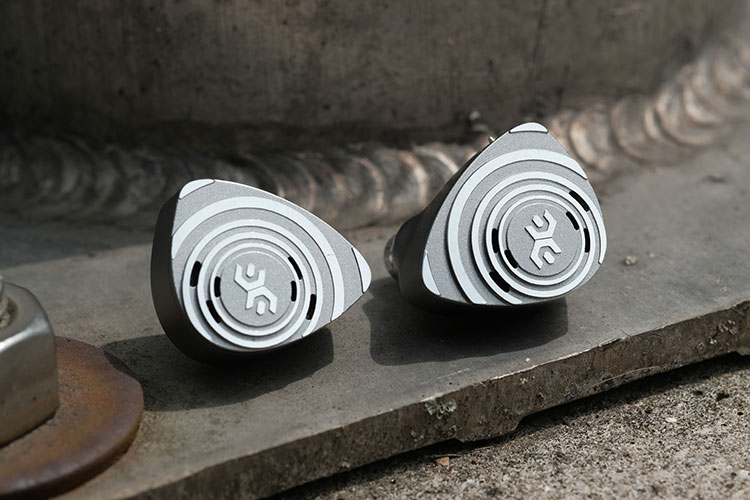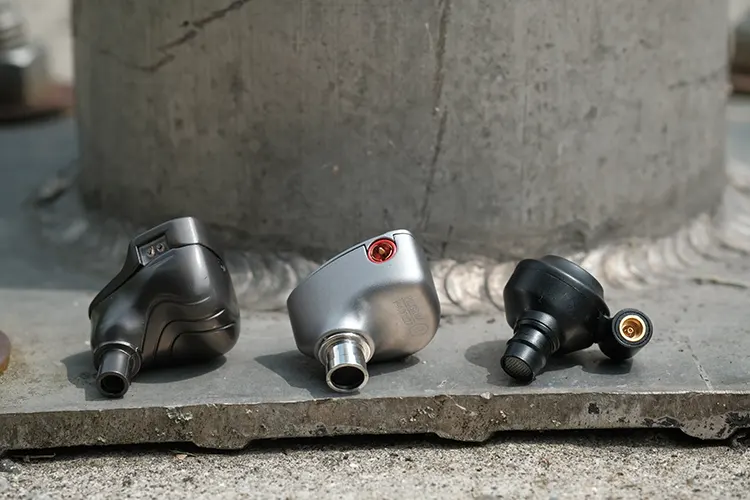Synergy
Efficiency
The Pilgrim has a sensitivity of 101 dB @ 1 kHz mW and an impedance of 9Ω @ 1 kHz.
I found it to be quite flexible across a variety of sources. There was no hiss from my TEAC HA-501, even with the filter set to maximum. Even my FX Audio D302 Pro sounded clean, even if it did alter the signature negatively making the Pilgrim thin and bright.
The Earstudio HUD100’s high-output port was the only thing that caused issues, namely a harsh pop when plugged in, and an ever-present background hiss. This makes sense given it is intended to be used with insensitive, high-impedance products, which the Pilgrim is not.
None of my other dongles, DAPs, or DACs provided a compromised experience. This leaves the Pilgrim in a good place when it comes to synergy.
Pairings
Dongles
ddHiFi’s performant TC44C and Earstudio’s versatile HUD100 were recruited for testing the Pilgrim.
Starting with the HUD100, I found it a moderately successful partner for the Pilgrim. There were no issues with hiss, nor maximum or minimum listening volumes.
It did a good job of retaining the Pilgrim’s spacious soundstage and did not hinder the impressive sub-bass extension from the dynamic driver.
Instead, I found the HUD100 to remove energy from the Pilgrim’s performance resulting in a dulled and unexpressive output. Swapping over to the HUD100’s “Dynamic” mode helped return some of this energy, but not enough to make the two my preferred pair.
If the HUD100 is all you had, you’d still have a good time with the Pilgrim, but there are better options. Options like ddHiFi’s TC44C!
The Pilgrim and the TC44C are a match made in heaven. The TC44C’s smooth, analog presentation retained the Pilgrim’s vibrant demeanor while adding warmth and weight to the mids and treble.
While it didn’t correct the moderate sibilance, treble edginess, or splash the Pilgrim can display, they were masked enough to be mostly a non-issue. In comparison, the HUD100 did not provide this benefit.
The staging was equally as impressive from the TC44C as the HUD100, with inconsequential improvements to layering the imaging that are only apparent in direct a/b comparisons, and just barely.
Select Comparisons
DUNU DK-3001 PRO
Technical
Both earphones are hybrids but with differing driver counts. The DK-3001 PRO contains a big 13mm beryllium-coated dynamic and four custom Knowles armatures while Pilgrim makes do with “only” one 9.2mm LSR dynamic and three custom armatures from Sonion.
There is some overlap in the materials used, but it is minimal. The Pilgrim uses mainly aluminum for the shell with stainless steel nozzles, while the DUNU utilizes machined stainless steel across the board.
The LYRE cable included with the DK-3001 PRO is thinner, lighter, and more flexible than the Pilgrim’s cable, but with weaker noise suppression qualities.
LYRE also gives you access to DUNU’s Quick-Switch system which lets you swap out to a balanced connection without needing to swap the entire cable.
DUNU’s DK-3001 PRO has a sensitivity of 112 dB vs. the Pilgrim’s 101 dB, with the impedance of the DK–3001 Pro being 20Ω to the Pilgrim’s 9Ω. The DK3001 Pro showed itself to be easier to bring up to volume.
Design
These two models take completely different approaches to their design with the DUNU being shockingly compact given the driver count and dynamic driver size.
It’s a good thing it’s so much smaller, as the choice to go with steel makes it the heavier of the two by about a gram (single earpiece only, no tip).
This is noticeable in the hand, but not so much when in the ear given the DK-3001 PRO’s superior ergonomics. The compact circular shape, longer and thinner nozzle, and rounded edges front and rear combined with a cable-up design ensure no hot spots and a consistent seal.
Looks being subjective, I feel the Pilgrim walks all over the reserved DK-3001 PRO. With its bright silver shells and cable and stunning faceplate design, the Pilgrim is a looker.
In contrast, the DK-3001 PRO is matte black with subtle silver accents surrounding the logo. It looks nice but does little to stand out, especially compared to the Pilgrim and all the flashy resin-based models being released.
DUNU’s decision to use MMCX means it offers a larger variety of third-party cable options, most of which should fit without issue given the protruding port design. The Pentaconn connectors of the Pilgrim limit third-party alternatives, but hopefully, this will change over time.
That said, I don’t know why you’d want to swap out either cable as they’re both amazing for a variety of reasons.
Passive isolation from both products is well above average. The DUNU better masks midrange tones, while the Pilgrim does a better job with higher and lower tones, letting through midrange tones in a similar way to the Campfire Audio Andromeda 2020 and IO, just not as prominently.
Performance
Bass on the Pilgrim is more sub-bass focused compared to the DK-3001 PRO while offering improved extension and texturing. The DK-3001 PRO has a more even sub- and mid-bass balance, with a thicker, warmer, slower presentation.
This weightiness carries into the midrange, which is darker, smoother, and less detailed on the DK-3001 PRO. It is more forward though, with a more intimate default vocal positioning that makes it the better of the two for vocal-centric tracks.
Treble is where the two take a drastic turn from each other. The DUNU has a notable roll-off in the brilliance region resulting in a considerably darker and less airy presentation.
The presence region is prominent though, so clarity isn’t far off what the Pilgrim produces. This more relaxed presentation leaves the DUNU as the less technically impressive of the two, but also less fatiguing.
The Pilgrim’s staging is quite a bit larger than what the DUNU can produce. The more distanced default vocal positioning sets the stage for the Pilgrim to immediately have a more open presentation.
Add to that a leaner note presentation, more airy upper treble, and sub-bass floor, and the Pilgrim’s staging is quite a bit more spacious in every direction.
The DK-3001 PRO images almost well and does not fall behind when keeping tracks well-layered and instruments and effects separated. Still, the Pilgrim is the more technically adept of the two.
I find the DUNU to have a more mature and balanced tune, but this comes at the expense of character and some technical competence. The Pilgrim provides more wow factor to its signature, with improved technical ability to back it up.
Earsonics Corsa
Technical
Like the Pilgrim, the Corsa utilizes an all-metal body design with 3D-printed internals. Though similar in size, the Corsa is the larger, thicker, considerably heavier model (6.8g vs. 17.1g, single earpiece, no tip).
The Pilgrim’s Pentaconn connectors limit third-party cable options, but the quality of the stock cable makes this sting less.
On the other side, the Corsa’s 0.78mm 2-pin system opens countless cable opportunities, at the expense of durability, which with the weight of this earphone is a point of contention.
Whereas the Pilgrim is a quad-driver hybrid with one dynamic and three armatures, the Corsa exclusively uses three balanced armatures. In both products, the drivers are customized for the brand with frequency separation handled by electronic crossovers.
The Pilgrim has a sensitivity of 101 dB compared to the Corsa’s 119 dB. The Volare’s impedance is 9Ω to the Corsa’s 31Ω. It takes less effort to bring the Corsa up to listening volumes.
Design
Both models have a similar triangular, Dorito’esque shape with the Corsa being the more curvaceous of the two. Like the Pilgrim, the Corsa has a similar sort of wavelet/knoll look going on, but it’s on the inner half of the body that presses up against the ear.
While the Corsa has the ergonomic advantage based purely on the additional lumps and bumps that better conform to the ear, the weight keeps it from staying comfortable and threatens to compromise the seal.
Similarly, the Pilgrim is quite comfortable, at least until the sharp edges of the faceplate cause discomfort and force you to take a break.
Elysian Acoustic Labs knocked the Pilgrim’s design out of the park. As such its bright, detailed shells offer a more interesting, attractive look.
That’s not to say the Corsa is lacking, as I think it looks quite pleasant thanks to some unique angling on the faceplate. The monotone color choice is what brings it down, as there is nothing beyond shadows to highlight the design features.
Isolation qualities are similar between the two. The Corsa slightly better dulls outside noise, but not excessively so thanks to large vents located on the rear of each shell.
Performance
Bass on the two takes a different approach with the Corsa having an even balance of mid- and sub-bass emphasis, vs. the Pilgrim’s sub-bass bias. The Pilgrim’s driver is slower but better extended with more visceral feedback and similarly good texturing.
The midrange of the Corsa is sibilance-free, thicker, warmer, and more forward giving vocalists a greater presence when compared to the Pilgrim.
It doesn’t sound as natural or provide nearly as much detail, which combined with the thickness leaves it almost muffled sounding when quickly swapping between the two.
Treble out of the Corsa is biased in the presence region with minimal extension into the brilliance region, giving it a more mellow, balanced presentation than the Pilgrim.
The Pilgrim provides more air, better clarity, and a lot more sparkle, at the expense of some harshness and eventual listening fatigue not found in the Corsa.
Staging on the Pilgrim is wider and deeper with more air between instruments, though the Corsa isn’t far behind which was unexpected given the rolled-off upper ranges and lack of sub-bass extension.
Technical ability is firmly on the Pilgrim’s side with its leaner presentation giving it the advantage in imaging precision, layering, and instrument separation.
The Corsa is the more neutral-leaning product of the two with good all-around performance. The Pilgrim’s more vibrant signature and superior technical capabilities reveal it to be the more versatile and entertaining earphone.
My Verdict
Elysian Acoustic Labs has made a competitive mid-range IEM in the Pilgrim. While it doesn’t wow in the specs with a crazy number of drivers or varied driver types, its sound signature is entertaining and performs at a very high technical level for this price point.
Their dynamic driver provides a level of performance that wouldn’t be unwelcome in a considerably more expensive earphone. The clarity, dynamic sound stage, and impressive staging qualities reward the listener.
It’s a beautiful earphone too, made from quality materials. The cable is truly spectacular as well, with some of the best noise mitigation qualities I’ve seen.
Downsides are present, however. The packaging shows the potential to damage the Pentaconn connectors, a sharp edge to the housing causes discomfort, and some minor sibilance and treble edginess are heard that blemish an otherwise killer tune.
As one of the better mid-range products I’ve come across, the Pilgrim is easy to recommend and deserving of the praise it has received thus far.
Elysian Acoustic Labs Pilgrim Technical Specifications
- Frequency Response: 10Hz–20kHz
- SPL: 101 dB @ 1 kHz @ 100mV
- Impedance: 9 Ohms @ 1 kHz






